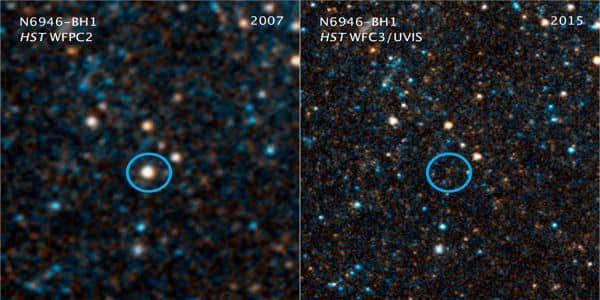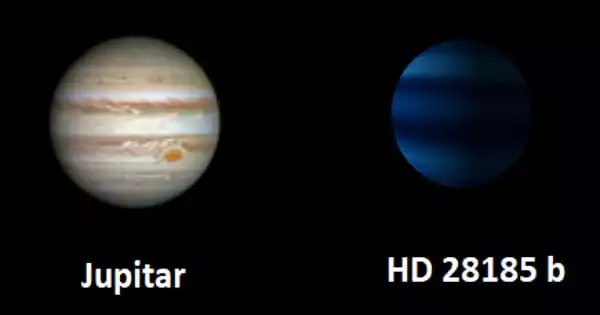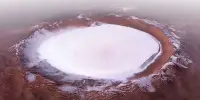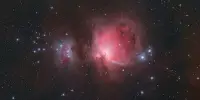A study that combined systematic observations with cosmological simulations discovered that, surprisingly, black holes can aid in the formation of new stars in certain galaxies. On the scale of galaxies, the role of supermassive black holes in star formation was previously thought to be destructive – active black holes can deplete galaxies of the gas required to form new stars. The new findings, published in the journal Nature, show how active black holes can instead “clear the way” for galaxies that orbit within galaxy groups or clusters, preventing star formation from being disrupted as they fly through the surrounding intergalactic gas.
Active black holes are thought to have a primarily destructive effect on their surroundings. They heat up and eject gas from their host galaxy as they blast energy into it, making it more difficult for the galaxy to produce new stars. However, researchers have discovered that the same activity can actually aid in star formation – at least for satellite galaxies orbiting the host galaxy.
The unexpected outcome resulted from a lunchtime conversation between astronomers who specialize in large-scale computer simulations and observers. As such, it is an excellent example of the type of informal interaction that has become increasingly difficult in pandemic conditions.
Astronomical observations that include taking a distant galaxy’s spectrum – the rainbow-like separation of a galaxy’s light into different wavelengths – allow for fairly direct measurements of that galaxy’s rate of star formation.
Research combining systematic observations with cosmological simulations has found that, surprisingly, black holes can help certain galaxies form new stars.
According to such measurements, some galaxies are forming stars at relatively slow rates. Each year, only one or two new stars are born in our own Milky Way galaxy. Others experience brief bursts of excessive star formation activity, known as “star bursts,” in which hundreds of stars are born each year. In some galaxies, star formation appears to be suppressed, or “quenched,” as astronomers call it: These galaxies have essentially stopped forming new stars.
So-called satellite galaxies are a type of galaxy whose specimens are frequently found to be in such a quenched state (nearly half of the time). These galaxies are part of a group or cluster of galaxies, have a low mass, and orbit a much larger central galaxy in the same way that satellites orbit the Earth.
Such galaxies typically form very few new stars, if any at all, and astronomers have suspected that something akin to a headwind may be to blame since the 1970s: groups and clusters of galaxies contain not only galaxies, but also rather hot thin gas filling the intergalactic space.
As a satellite galaxy orbits through the cluster at hundreds of kilometers per second, the thin gas creates the same kind of “headwind” that a fast bike, or motorbike, would experience. The stars in the satellite galaxy are far too close together to be affected by the steady stream of intergalactic gas.
However, the gas in the satellite galaxy is not: it would be stripped away by the oncoming hot gas in a process known as “ram pressure stripping.” A fast-moving galaxy, on the other hand, has no chance of attracting enough intergalactic gas to replenish its gas reservoir. As a result, such satellite galaxies lose almost all of their gas – and thus the raw material required for star formation. As a result, star formation would be stifled.
Because the processes in question occur over millions, if not billions, of years, we cannot directly observe them. Even so, there are avenues for astronomers to pursue further education. They can use computer simulations of virtual universes that are programmed to follow the relevant physics laws – and compare the results to what we actually see. And they can look for tell-tale signs in astronomical observations’ comprehensive “snapshot” of cosmic evolution.

Annalisa Pillepich, a group leader at the Max Planck Institute for Astronomy (MPIA), is an expert in such simulations. The IllustrisTNG simulation suite, which Pillepich co-led, provides the most detailed virtual universes to date, allowing researchers to track the movement of gas on comparatively small scales.
IllustrisTNG contains some extreme examples of satellite galaxies that have been freshly stripped by ram pressure: so-called “jellyfish galaxies,” which trail the remnants of their gas like jellyfish trail their tentacles. In fact, identifying all of the jellyfish in the simulations is a recently launched citizen science project on the Zooniverse platform, where volunteers can contribute to research into that type of freshly quenched galaxy.
However, while jellyfish galaxies are interesting, they are not where the current research project began. Over lunch in November 2019, Pillepich told Ignacio Martn-Navarro, an astronomer specializing in observations who was at MPIA on a Marie Curie fellowship, about one of her IllustrisTNG results. A finding concerning the influence of supermassive black holes that extended beyond the host galaxy and into intergalactic space.
Supermassive black holes like this can be found at the center of all galaxies. Matter that falls into such a black hole typically becomes part of a rotating accretion disk before falling into the black hole itself. This impact on the accretion disk releases enormous amounts of energy in the form of radiation and, in some cases, two jets of rapidly moving particles that accelerate away from the black hole at right angles to the accretion disk. An Active Galactic Nucleus, or AGN for short, is a supermassive black hole that emits energy in this manner.
While IllustrisTNG does not go into great detail about black hole jets, it does include physical terms that simulate how an AGN adds energy to the surrounding gas. And, as the simulation demonstrated, that energy injection will result in gas outflows, which will then orient themselves along the path of least resistance: in the case of disk galaxies like our own Milky Way, perpendicular to the stellar disk; and in the case of so-called elliptical galaxies, perpendicular to a suitable preferred plane defined by the arrangement of the galaxy’s stars.
Over time, the bipolar gas outflows perpendicular to the disk or preferred plane will reach the intergalactic environment – the thin gas that surrounds the galaxy. They will push the intergalactic gas away, with each outflow forming a massive bubble. This account prompted Pillepich and Martn-Navarro to consider what would happen if a satellite galaxy passed through that bubble: would it be affected by the outflow, and would its star formation activity be suppressed even further?
Martn-Navarro addressed this issue within his own domain. He had extensive experience working with data from one of the most extensive systematic surveys to date, the Sloan Digital Sky Survey (SDSS), which provides high-quality images of a large portion of the Northern hemisphere. He examined 30,000 galaxy groups and clusters, each of which contained a central galaxy and on average four satellite galaxies, in the publicly available data from that survey’s tenth data.
In a statistical analysis of those thousands of systems, he discovered a small but noticeable difference between satellite galaxies that were close to the preferred plane of the central galaxy and satellites that were significantly above and below. However, the difference was not in the expected direction: satellites above and below the plane, within the thinner bubbles, were not only not more likely, but also about 5% less likely to have had their star formation activity quenched.
With that unexpected result, Martn-Navarro returned to Annalisa Pillepich, and the two conducted the same type of statistical analysis in the virtual universe of the IllustrisTNG simulations. After all, cosmic evolution is not added “by hand” by the researchers in such simulations. Instead, the software includes rules that as naturally as possible model the physics rules for that virtual universe, as well as suitable initial conditions that correspond to the state of our own universe shortly after the Big Bang.
That is why simulations like that allow for the unexpected, in this case, re-discovering the on-plane, off-plane distribution of quenched satellite galaxies: For the quenching of satellite galaxies, the virtual universe showed the same 5% deviation! The researchers were clearly onto something.
Pillepich, Martn-Navarro, and their colleagues eventually developed a hypothesis for the physical mechanism underlying the quenching variation. Consider a satellite galaxy passing through one of the thinned-out bubbles blown into the surrounding intergalactic medium by the central black hole. Because of its lower density, that satellite galaxy experiences less headwind and ram pressure, making it less likely to have its gas stripped away.
Then it’s all about statistics. The effect will be insignificant for satellite galaxies that have already orbited the same central galaxies several times, traversing bubbles as well as the higher-density regions in between. Such galaxies will have long since lost their gas.
However, for satellite galaxies that have recently joined the group, or cluster, location matters: if those satellites land in a bubble first, they are less likely to lose their gas than if they land outside a bubble. This effect could explain the statistical difference between quenched satellite galaxies.
This is a very promising result, with excellent agreement between the statistical analyses of the SDSS observations and the IllustrisTNG simulations, and a plausible mechanism hypothesis. It is particularly interesting in the context of galaxy evolution because it indirectly confirms the role of active galactic nuclei in not only heating intergalactic gas, but also actively “pushing it away” to create lower-density regions. And, as with any promising result, there are now a number of natural directions that Martn-Navarro, Pillepich, and their colleagues, as well as other scientists, can take to investigate further.
















